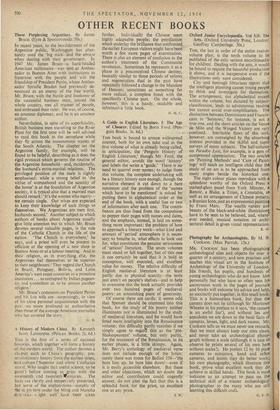Tins, the last in order of the entire twelve- volume
plan, is the tenth volume to be published of the only serious encyclopaedia for children'. Dealing with the arts, it would be bound to require the beautiful production it shows, and it is inexpensive even if the illustrations only were considered. City and borough librarians report that the intelligent planning causes young people to think and investigate for themselves. The arrangement, riot alphabetical except within the volume, but dictated by subject- classification, leads to adventurous reading but cannot avoid over-simplification. The distinction between Dominicans and Francis- cans in 'Sermons,' for instance, is not a true one, and the short articles on the Venus de Milo and the Winged Victory are very confused. Inevitable flaws of this sort, however, are outweighed by the absorbing interest provided in the skilful and rapid surveys of many subjects. The half-column on Paradise Lost, for example, is a gem of compressed appreciation. The two articles on 'Painting Methods' and 'Care of Paint- ings' will teach an intelligent child that the study of an art is to be approached from many angles beside the historical one.
The eight colour plates reproduce with a splendour worthy of the Oxford Press a stained-glass panel from York Minster, a Renoir, a Blake, a Titian, a Constable, as well as an arrangement of Chinese pottery, a Russian Icon, and an expressionist painting by Franz Marc. The wealth variety and beauty of the black-and-white illustration! have to be seen to be believed, and, where.- ever needed, musical notation or archi- tectural detail is given visual representation.
K. CI.


































 Previous page
Previous page